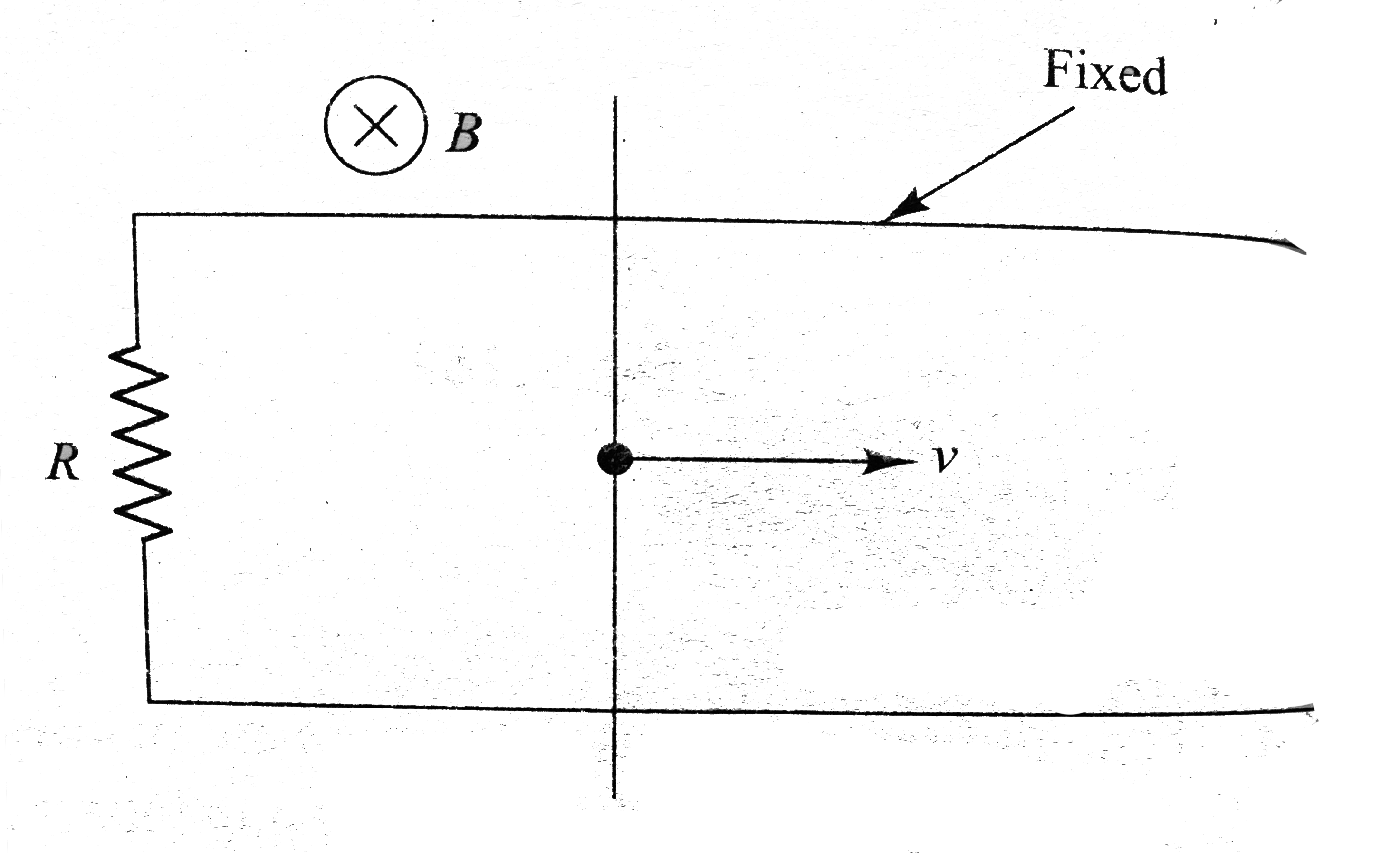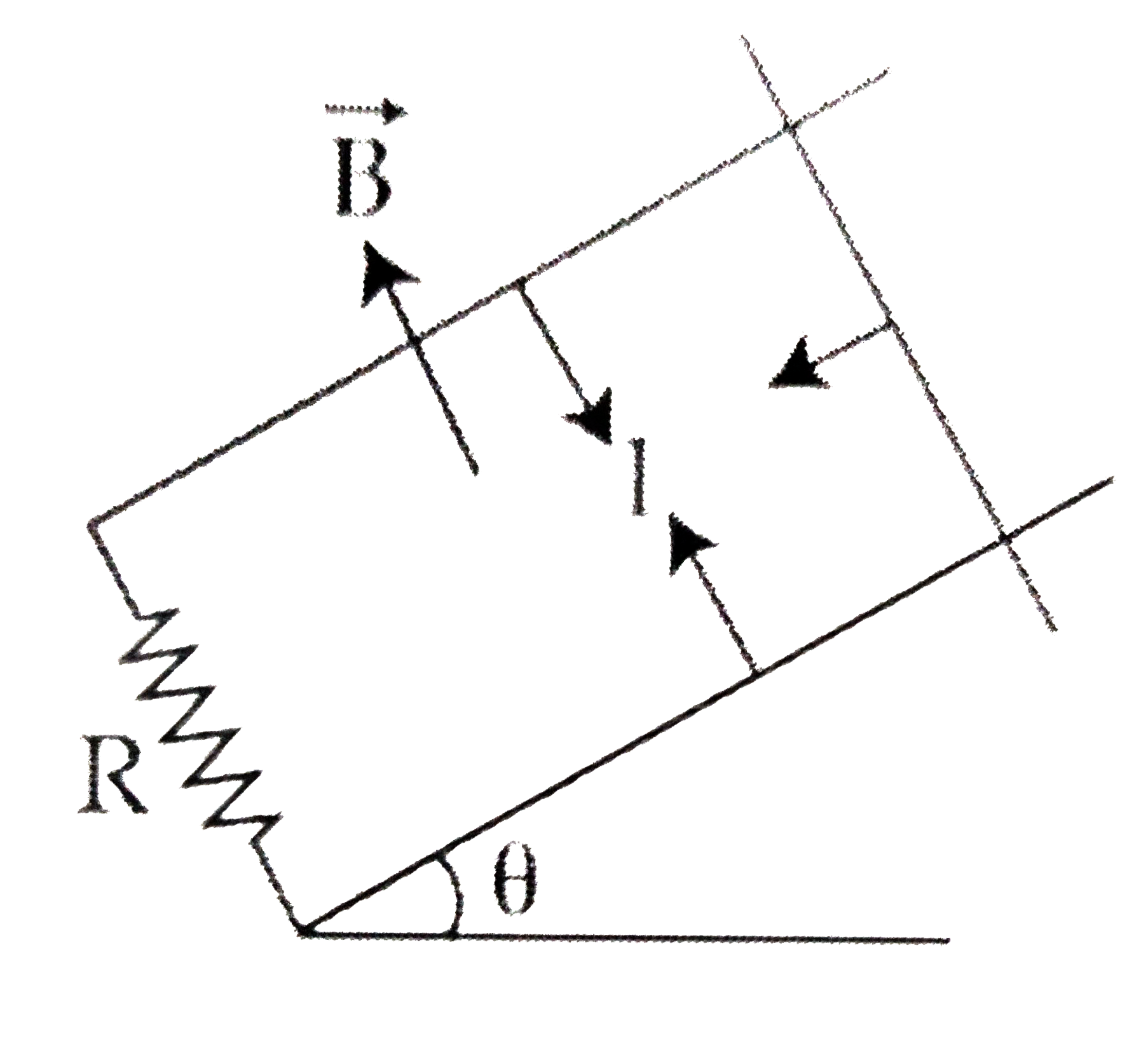A conducting rod XY slides freely on two parallel rails, A and B, with a K uniform velocity V. A galvanometer G is connected as shown in the figure and the closed circuit has a total resistance R. A uniform magnetic field, A perpendicular to the plane defined by the rails A and B and the rod XY (which are mutually perpendicular), is present over the region as shown.

(a) With key K open: (i) Find the nature of charges developed at the ends of the rod XY (ii) Why do electrons, in the rod XY (finally), experience no B net force even through the magnetic force is acting on them due to the motion of the rod?
(b) How much power needs to be delivered (by an external agency) to keep the rod moving at its uniform speed when key K is (i) closed (ii) open?
(c) With key K closed, how much power gets dissipated as heat in the circuit? State the source of this power.
(a) According to Fleming.s Left hand rule, the free electrons of the rod experience a force in a direction from Y to X. Therefore, at X, negative charge will be developed and at Y, positive charge will be developed.
(i) As the force experienced by moving electrons due to magnetic field is balanced by the force experienced due to electric field. Hence, Net force experienced by electrons is zero finally.
(b) (i) As Power = FU
F=BIlsin90∘=BεRl
As ε=Blv∴F=BBlvRl=B2l2vR
Hence Power=Fv=B2l2vRv=B2l2vR
(ii) When the key is open, Power delivered will be zero. Because, in this case, there will be no induced emf or no current. (c) Power dissipated as heat = I2R
=(εR)2R
=(BlvR)2R
=B2l2vR
Topper's Solved these Questions
- BOOK - MODERN PUBLICATIONCHAPTER - ELECTROMAGNETIC INDUCTIONEXERCISE - COMPETITION FILE (EXEMPLAR PROBLEMS)(OBJECTIVE QEUSTIONS)10videos
ELECTROMAGNETIC INDUCTION
- BOOK - MODERN PUBLICATIONCHAPTER - ELECTRIC CHARGES AND FIELDS EXERCISE - Chapter Practice Test15videos
ELECTRIC CHARGES AND FIELDS
- BOOK - MODERN PUBLICATIONCHAPTER - ELECTROMAGNETIC WAVESEXERCISE - CHAPTER PRACTICE TEST14videos
ELECTROMAGNETIC WAVES
Similar Questions
A square of side L meters lies in the x-y plane in a region, where the magnetic field is give by B=B0(2ˆi+3ˆj+4ˆk)T, where B0 is constant. The magnitude of flux passing through the square is
04:02View SolutionWhy electrostatic field is normal to the surface at every point of a charged isolated conductor?
04:16View SolutionCan a displacement current produce a magnetic field as the conduction current does ?
04:21View SolutionA conducting rod of length l slides at constant velocity v on two parallel conducting rails, placed in a uniform and constant magnetic field B perpendicular to the plane of the rails as shown in Fig.3.49. A resistance R is connected between the two ends of the rails.

(a) Idenify the cause which produces change in magnetic flux.
(b) Identify the direction of current in the loop.
( c) Determine the emf induced in the loop.
(d) Compute the electric power dissipated in the resistor.
(e) Calcualte the mechenical power required to pull the rod at a cinstant velovity.08:53View SolutionStatement I: A resistance R is connected between the two ends of the parallel smooth conducting rails. A conducting rod lies on these fixed horizontal rails and a uniform constant magnetic field B exists perpendicular to the plane of the rails as shown in Fig. if the rod is given a velocity υ and released as shown in Fig. 3.188, it will stop after some time. the total work done by magnetic field negative.

Statement II: If force acts opposite to direction of velocity its work done is negative.06:37View SolutionA conducting rod of length is moved at constant velocity v0 on two parallel, conducting, smooth, fixed rails, that are placed in a uniform constant magnetic field B perpendicular to the plane for the rails as shown in Fig. A resistance R is connected between the two ends of the rails.
Then which of the following is/are correct:
 02:00View Solution
02:00View SolutionTwo parallel fixed conducting rails are l distance apart. They are connected by a conducting wire xy. A uniform magnetic field B is applied normal to its plane. Two other rods PQ and RT(RS = ST) are moved with a constant velocity v. Resistance/ length of these two rods are lamda no other wire has resistance. Then :
06:26View Solution
a copper rod of mass m slides under gravity on two smooth parallel rails with separation I and set at an angle of θ with the horiziontal at the bottom rails are joined by resistance R. There is a uniform magnetic field B normal to the plane of the rails as shown in the figure The terminal speed of the copper rod is :02:54View SolutionFollowing figure shows a metal rod PQ resting on the smooth ralls AH and positioned between the poles of a permanent magnet. The rails, the rod and the magnetic field are in three mutual perpendicular directions. A galvanometer G connects the rails through a switch K. Length of the rod 15 cm, B 0.50 T, resistance of the closed loop containing the rod 9.0mΩ. Assume the field to be uniform.
What is the induced emf in the moving rod if the magnetic field is parallel to the rails instead of being perpendicular?03:45View SolutionA metal rod PQ is resting on the rails A'B' and positioned between the poles of a permanent magnet. The rails, the rod and the magnetic field are in three mutually perpendicular directions. A galvanometer G connects the rails through a switch K. Length of the rod = 15 cm, B = 0.50 T, resistance of the closed loop containing the rod = 9.0 mOmega . Assume the field to be uniform. Suppose K is open and the rod is moved with a speed of 12 cm. s^(-1) in the direction shown. Give the polarity and magnitude of the induced emf.
07:51View Solutionएक कॉपर की छड़ का द्रव्यमान m है। यह दो क्षैतिज समान्तर चिकनी पटरियों (rails) जिनके बीच की दूरी । है तथा क्षैतिज के साथ θ कोण बनाती है, पर गुरुत्व के अन्तर्गत फिसलती है। तली में पटरियाँ एक प्रतिरोध R के द्वारा चित्रानुसार जुड़ी हैं। यहाँ एकसमान चुम्बकीय क्षेत्र B पटरियों (rails) के तल के लम्बवत् है। छड़ का क्रान्तिक वेग है
 04:08View Solution
04:08View Solutiona copper rod of mass m slides under gravity on two smooth parallel rails with separation I and set at an angle of theta with the horiziontal at the bottom rails are joined by resistance R. There is a uniform magnetic field B normal to the plane of the rails as shown in the figure The terminal speed of the copper rod is :
04:19View SolutionA conducting rod of length l slides at constant velocity v on two parallel conducting rails, placed in a uniform and constant magnetic field B perpendicular to the plane of the rails as shown in Fig.3.49. A resistance R is connected between the two ends of the rails.

(a) Idenify the cause which produces change in magnetic flux.
(b) Identify the direction of current in the loop.
( c) Determine the emf induced in the loop.
(d) Compute the electric power dissipated in the resistor.
(e) Calcualte the mechenical power required to pull the rod at a cinstant velovity.06:30View SolutionA conducting rod of length is moved at constant velocity v0 on two parallel, conducting, smooth, fixed rails, that are placed in a uniform constant magnetic field B perpendicular to the plane for the rails as shown in Fig. A resistance R is connected between the two ends of the rails.
Then which of the following is/are correct:
 02:53View Solution
02:53View SolutionStatement I: A resistance R is connected between the two ends of the parallel smooth conducting rails. A conducting rod lies on these fixed horizontal rails and a uniform constant magnetic field B exists perpendicular to the plane of the rails as shown in Fig. if the rod is given a velocity υ and released as shown in Fig. 3.188, it will stop after some time. the total work done by magnetic field negative.

Statement II: If force acts opposite to direction of velocity its work done is negative.04:18View SolutionTwo parallel fixed conducting rails are l distance apart. They are connected by a conducting wire xy. A uniform magnetic field B is applied normal to its plane. Two other rods PQ and RT(RS = ST) are moved with a constant velocity v. Resistance/ length of these two rods are lamda no other wire has resistance. Then :
02:05View Solution

